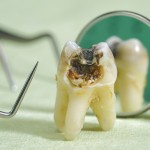
One of the main complications of dental restorations is considered to be secondary caries or ‘caries adjacent to restoration’ (CAR) . Several factors contribute to the risk of CAR, the patients’ overall caries risk, operator skill, local conditions and cervical extent. One other factor is the type of restoration material which may influence bacterial colonisation and growth an may release fluoride.
The aim of this review was to assess the impact of various restorative materials on CAR.
Methods
Searches were conducted in the Medline, Embase and Cochrane CENTRAL databases. Two reviewers independently selected studies and extracted data. In situ, controlled trials comparing directly placed restorative materials, reporting on caries (mineral loss, measured via radiography or micro-hardness) adjacent to these materials were considered.
The primary outcome was mineral loss of the carious lesion, assessed either via microradiography or micro-CT, or via hardness measurements (surface micro-hardness, cross-sectional micro- hardness). Materials were classified according to the used adhesive and restorative materials. Fixed-effects pairwise and frequentistic network meta-analyses were performed.
Results
- 9 studies involving 132 patients and 8 materials were included.
- Analysis produced inconsistent results.
Conclusions
The authors concluded: –
The current body of evidence of in situ studies is insufficient for firm conclusions as to the caries risk adjacent to different materials. The validity and applicability of included studies remain uncertain.
Comments
The authors chose to restrict the included studies to those conducted in situ because of the theoretical advantage of being able to standardise study conduct and outcome assessment. While this may be the case only a small number of patients were include in the studies with a broad range of material being tested providing a limited amount of data. This limited data has provided inconsistent results and while the in-situ approach may provide a more controllable experimental environment the generalisability of any findings to the clinical situation for decision making is more problematic.
Links
Primary paper
Askar H, Tu YK, Paris S, Yeh YC, Schwendicke F. Risk of caries adjacent to different restoration materials: Systematic review of in situ studies. J Dent. 2016 Sep 30. pii: S0300-5712(16)30187-7. doi: 10.1016/j.jdent.2016.09.011. [Epub ahead of print] Review. PubMed PMID: 27697582.
